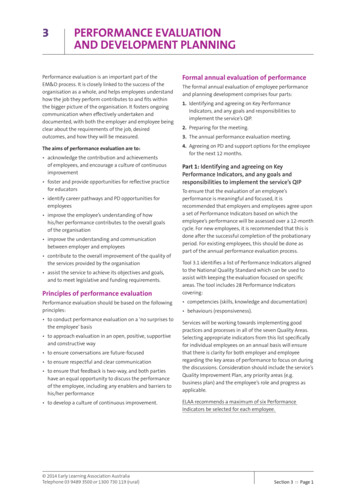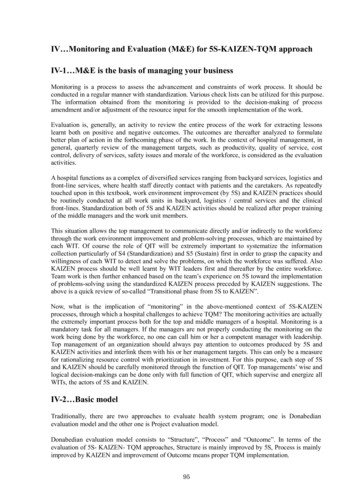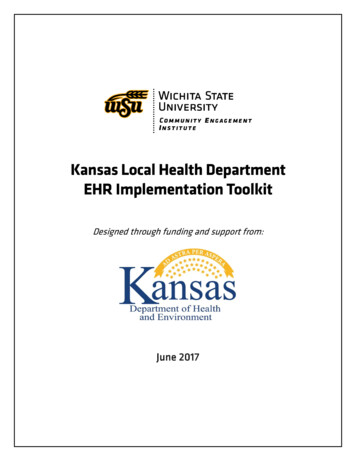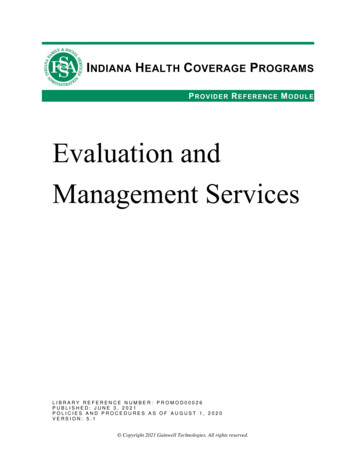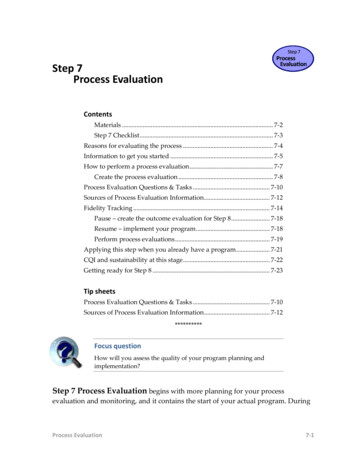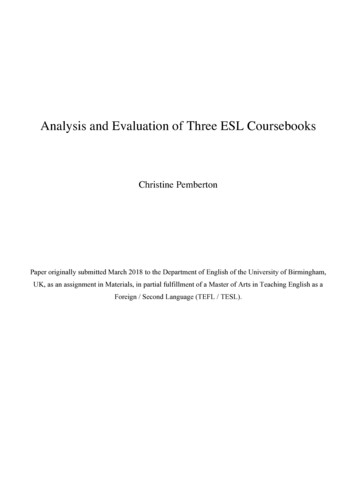
Transcription
Analysis and Evaluation of Three ESL CoursebooksChristine PembertonPaper originally submitted March 2018 to the Department of English of the University of Birmingham,UK, as an assignment in Materials, in partial fulfillment of a Master of Arts in Teaching English as aForeign / Second Language (TEFL / TESL).
SM/18/04Make a collection of a total of three different units, one unit from each of three different EFL/ESLcoursebooks, and identify: the main teaching pointsthe main teaching methodology/methodologies employed in each unitthe syllabus fit i.e. how the content of the unit relates to the content of preceding and succeedingunitsthe type of syllabus employed by the bookthe intended learner/teaching situationEvaluate the content of each unit. Describe the strengths and weaknesses of each of the units.How well does the material achieve the stated aims of objectives?How well does the material fit the stated learning situation?Would you use any of the units you have chosen in your own teaching situation?1 IntroductionTeaching materials have a considerable impact on what teachers teach and how they teach it(Cunningsworth, 1995: p. 7). While there is no one agreed upon procedure for evaluating coursebooks,evaluation aids teachers in understanding their underlying theoretical rationale and how to mosteffectively use them (McDonough, Shaw, & Masuhara, 2013). This paper will analyze and evaluatethree coursebooks with a focus on one unit of each: Passport: English for International Communication Level 1 (2nd edition), Angela Buckinghamand Lewis Lansford (2012): Unit 3 Active: Skills for Communication Intro, Chuck Sandy and Curtis Kelly (2011): Unit 5 Touchstone 1 (2nd edition), Michael McCarthy, Jeanne McCarten, and Helen Sandiford (2014):Unit 52 Analysis1
2.1 Framework of analysisAnalysis of materials should be objective, focusing on what materials contain, what they ask of learners,and what their aims are (Tomlinson, 2012). This paper uses Littlejohn’s framework, which Littlejohnclaims allows evaluators to come to their own conclusions about the suitability of a textbook (Littlejohn,2011). McGrath (2002: p. 48) argues that this process is inherently value-laden, and Tomlinson (2012:p. 148) states that the selection of questions itself involves bias. While it may be impossible to avoid allsubjectivity, this framework was chosen for its capacity for in-depth analysis through three levels.Level 1 is an objective description of what the materials contain. Level 2 is a subjective analysis of“tasks,” which Littlejohn defines as “any proposal contained within the materials for action to beundertaken by the learners.” Level 3 is a subjective inference about the principles of the material basedon Levels 1 and 2. These are summarized in Figure 1.Figure 1: Levels of analysisLevel 1: Objective description (what is there)lStatements of descriptionlPhysical aspects of the materialslMain steps in the instructional sectionsLevel 2: Subjective analysis (what is required of users)lSubdivision into constituent taskslAn analysis of tasks: What is the learner expected to do? Who with? Withwhat content?Level 3: Subjective inference (what is implied)lDeducing aims, principles of selection and sequencelDeducing teacher and learner roleslDeducing demands on learners’ process competence2
Analyses of the three textbooks can be found in Appendices 1, 2, and 3. For the Level 2 analysis, due tothe high volume of material, optional tasks suggested in the teacher’s books were not counted. Checkinglearners’ answers was not counted unless it had a communicative purpose (e.g. sharing results of adiscussion). In the “turn take” category, the new subcategory “scripted response plus initiate” wasadded for tasks which partially provide a script for speaking activities. Under “output of learners,” thenew subcategory “circle/check/letter/number” was created for tasks which required such output.2.2 Main teaching pointsThis section coincides with Level 1 of Littlejohn’s framework (see Appendix 1). The selected unitsfrom each textbook share thematic similarities of discussing habits, routines, and traditions.2.2.1 Passport 1The teaching points of Passport 1 include grammar, vocabulary, and functions. The main teachingpoints of Unit 3 are shown in Table 1.Table 1: Teaching points of Passport 1 Unit 3GrammarVocabularyFunctionssimple presentwords to describe hobbies and transportationdescribing routines of oneself and family members2.2.2 Active IntroThe teaching points of Active 1 include grammar, vocabulary, functions, and conversation strategies.The main teaching points of Unit 5 are shown in Table 2.Table 2: Teaching points of Active Intro Unit 5GrammarVocabularyFunctionsConversation Strategiesfrequency adverbsholidays/special days, holiday activitiesdescribing daily and holiday routinesusing pause fillers3
2.2.3 Touchstone 1The teaching points of Touchstone 1 include grammar, vocabulary, functions, conversation strategies,and pronunciation. The main teaching points of Unit 5 are shown in Table 3.Table 3: Teaching points of Touchstone 1 Unit 5GrammarVocabularyFunctionsConversation StrategiesPronunciationsimple present information questions, frequency adverbstypes of TV shows, free-time activities, time expressions for frequency,expressions for likes and dislikesdiscussing free-time activities, talking about TV shows you like anddon’t like, talking about TV viewing habitsasking questions in two ways to be clear and not too direct, using “Imean” to repeat your idea or say more“do you”2.3 Teaching MethodologyMethodology is “the existence of a set of procedures related by an underlying rationale or theory ofteaching and language learning” (Knight, 2001: p. 147). These procedures concern the skills and contentto be taught and the order in which content is presented (Anthony, 1963, cited in Richards and Rodgers,1986: p. 15). This section will present the results of the Level 2 task analysis (see Appendix 2) andexamine how information is presented in each unit.2.3.1 PassportTable 4 shows the results of the task analysis for Passport Unit 3. Many tasks require a scriptedresponse (66.67%), are form-focused (66.67%), and require repeating identically (41.67%). Learnersoften work in pairs (50%). Input is largely aural (91.67%), based on materials (91.67%), and based onfiction (58.33%). Output is mostly oral (75%), based on materials (66.67%), and based on students’own information (58.33%).4
Passport follows the Present Practice Production (PPP) methodology. PPP is based on Audiolingualism and attempts to teach communication through habit formation. It is a teacher-centeredmethodology with a focus on form over meaning (Harmer, 2007). An account of how Passport usesPPP is shown in Table 5.Table 4: Task analysis of PassportType of Task1 What is the learner expected to do?1.1 Turn takeInitiateScripted responseScripted response plus initiateNot required% of AllTasksin UnitType of Task% of AllTasks inUnit33.3366.67003 With what content?3.1 Input to learnersForm:GraphicWords/phrases/sentences: writtenWords/phrases/sentences: aural58.3366.6791.671.2 FocusLanguage system (rules or form)MeaningMeaning/system/form ner(s)91.670251.3 Mental operationRepeat identicallyRepeat selectivelyRepeat with expansionRetrieve from STM/working memoryFormulate items into larger unitDecode semantic meaningSelect informationCategorize selected informationHypothesizeFormulate language ruleApply stated language ruleAttend to example/explanationExpress own .678.338.3333.3341.67Nature:Metalinguistic commentLinguistic itemsNon-fictionFictionPersonal information/opinion8.330058.33503.2 Output from s/phrases/sentences: writtenWords/phrases/sentences: oral8.338.338.33752 Who with?Teacher and learner(s), class observingLearners to the whole classLearners individually simultaneouslyLearners in pairs/groups s)66.67033.33Linguistic itemsNon-fictionFiction0041.675
Personal information/opinion58.33Table 5: Use of PPP in PassportSection Nameimage (no name)“Listening”“Look and Learn”“Conversation”“Over to You”“Activity”Type of Taskwarm-uplisteningdrilling, practice with a partnerlistening, drilling, practice with a partnersubstitution practice with a partnerfreer expansionPPP Stagepresentationpracticeproduction2.3.2 ActiveTable 6 shows the results of the task analysis for Active Unit 5. Many tasks require initiating (36.84%),and most focus on meaning (52.63%) and require expressing learners’ own ideas (57.58%). Learnersoften work individually (57.58%). Written input is always provided (100%), the source is often thematerials (52.63%), and the nature is often personal information (47.37%). Output is mostly written(42.11%) and oral (42.11%), comes from the learners (68.42%), and is often based on personalinformation (47.37%).Grammar points and vocabulary are presented deductively before learners practice using them to expresstheir own ideas. Listening is done in a “top-down” style, where learners listen for overall meaning(Harmer, 2001: p. 201). Conversation strategies are presented inductively within the context of thelistening task before learners are expected to practice using them. The “Challenge” at the end of the unitrequires learners to combine forms and lexis learned previously to accomplish a larger communicativetask.Table 6: Task analysis of ActiveType of Task1 What is the learner expected to do?% of AllTasks inUnitType of Task% of AllTasks inUnit3 With what content?6
1.1 Turn takeInitiateScripted responseScripted response plus initiateNot required36.8426.3221.0510.533.1 Input to learnersForm:GraphicWords/phrases/sentences: writtenWords/phrases/sentences: aural63.1610052.631.2 FocusLanguage system (rules or form)MeaningMeaning/system/form earner(s)52.63042.111.3 Mental operationRepeat identicallyRepeat selectivelyRepeat with expansionRetrieve from STM/working memoryFormulate items into larger unitDecode semantic meaningSelect informationCategorize selected informationHypothesizeFormulate language ruleApply stated language ruleAttend to example/explanationExpress own 5826.3257.58Nature:Metalinguistic commentLinguistic itemsNon-fictionFictionPersonal information/opinion5.265.265.2642.1147.373.2 Output from s/phrases/sentences: writtenWords/phrases/sentences: 1.58068.42Linguistic itemsNon-fictionFictionPersonal information/opinion0042.1147.372 Who with?Teacher and learner(s), class observingLearners to the whole classLearners individually simultaneouslyLearners in pairs/groups simultaneously5.265.2657.5831.582.3.3 TouchstoneTable 7 shows the results of the task analysis for Touchstone Unit 5. Many tasks require a scriptedresponse (47.46%). About half of tasks focus on meaning (50.08%), and many require learners toexpress their own ideas (42.37%). Learners usually work alone (45.76%) or in pairs (42.37%). Input ismainly written (89.63%), comes from the materials (84.75%), and is based on personal information(67.80%). Output is mainly oral (52.54%), comes from the materials (54.24%), and is based on personalinformation (67.80%).7
Grammar is taught inductively before being explicitly presented, followed by activities using thelanguage. Vocabulary and conversation strategies are both taught through top-down listening tasksbefore learners are expected to use them. Reading is taught through pre-reading, during reading, andpost-reading activities and focuses on meaning over form. Writing tasks focus on both meaning andform. Learner autonomy is encouraged with a “Vocabulary Notebook,” self-progress checks, andreading tips.Table 7: Task analysis of TouchstoneType of Task1 What is the learner expected to do?1.1 Turn takeInitiateScripted responseScripted response plus initiateNot required% of AllTasks inUnitType of Task% of AllTasks inUnit35.5947.468.478.473 With what content?3.1 Input to learnersForm:GraphicWords/phrases/sentences: writtenWords/phrases/sentences: aural35.5989.8364.411.2 FocusLanguage system (rules or form)MeaningMeaning/system/form Learner(s)84.75042.371.3 Mental operationRepeat identicallyRepeat selectivelyRepeat with expansionRetrieve from STM/working memoryFormulate items into larger unitDecode semantic meaningSelect informationCategorize selected informationHypothesizeFormulate language ruleApply stated language ruleAttend to example/explanationExpress own 93.3925.4215.2542.37Nature:Metalinguistic commentLinguistic itemsNon-fictionFictionPersonal information/opinion5.0811.863.3916.9567.803.2 Output from s/phrases/sentences: writtenWords/phrases/sentences: oral013.5628.8152.54MaterialsTeacher54.2402 Who with?Teacher and learner(s), class observing10.178
Learners to the whole classLearners individually simultaneouslyLearners in pairs/groups tic itemsNon-fictionFictionPersonal information/opinion10.171.6911.8667.802.4 SyllabusesA syllabus is “a specification of the content of a course of instruction and lists what will be taught andtested” (Richards, 2001: p. 2). Syllabuses may be either product- or process-oriented, the formerfocusing on what knowledge should be gained and the latter on the experiences that facilitate learning(Nunan, 1988). Multiple types of syllabuses may be combined in integrated syllabuses (Richards, 2001).2.4.1 PassportPassport uses a product-oriented situational syllabus with secondary functional, grammatical, andlexical strands. A situational syllabus presents the language that is typically used in specific settings.These types of syllabuses are often found in travel books and include situations one would encounterwhen traveling (Richards, 2001: pp. 156-157).In Unit 3 of Passport, two friends discuss their family members with a new friend. Sample sentencesand dialogues use the simple present, talk about routines of family members, and mention hobbies andtransportation. However, there are no explanations or activities focusing on these grammar, functions,or vocabulary. Thus, the situational syllabus strand takes precedence.2.4.2 ActiveActive uses a product-oriented integrated syllabus. This includes grammar, lexis, functions,communication strategies, social and psychological criteria, situations, and topics. Social criteriainclude getting to know classmates, creative thinking, opinion giving, and teamwork. Psychological9
criteria refers to some units requiring more self-disclosure than others. Each unit includes a“Challenge,” which “presents a real-life situation that learners may face when talking to Englishspeakers” (Sandy & Kelly, 2011: pp. vi-vii).In Unit 5, no particular syllabus strand taking on primary importance. Grammar and functionalobjectives are both taught through the use of frequency adverbs to describe holiday routines.Vocabulary for holidays and holiday activities are taught together, with holiday activities presented aschunks of language. Pause fillers, taught at the end of the unit, are also used while talking aboutholidays. One discrepancy is that the entire unit focuses on describing holiday routines and does notinclude daily routines as listed in the table of contents. Also, the “Challenge” asks students to create anew holiday, which is not a normal, real-life situation.2.4.3 TouchstoneTouchstone also uses a product-oriented integrated syllabus, which is predominantly lexical andgrammatical and also includes functions, conversation strategies, pronunciation, and topics. TheCambridge International Corpus is used to inform the order in which vocabulary, grammar, andconversation strategies are taught as well as the usage of particular grammar structures (McCarthy,McCarten, & Sandiford, 2014b: pp. iv-v). Vocabulary and grammar are recycled within each unit,which is essential to help learners memorize and get a full understanding of material (Cunningsworth,1995: p. 59).In Unit 5, Lesson A teaches simple present information questions and the pronunciation of “do you.”Lesson B adds in frequency adverbs, vocabulary for TV shows, and expressions for likes and dislikes.Lesson C teaches the conversation strategies of asking questions in two ways and using “I mean”.Lesson D includes reading and writing tasks that talk about habits. Frequency adverbs, time10
expressions, expressions for likes and dislikes, and present simple information questions are allintroduced and recycled within the unit.2.5 Syllabus fitThe organization of content in a syllabus is called grading, which includes sequencing and staging.Sequencing refers to ordering, fit, range of language taught, and whether or not language is recycled toaid in learners’ memorization. Staging involves how units are divided, the amount of material in eachunit, and the speed of progression (Cunningsworth, 1995: p. 59).2.5.1 PassportSituational syllabuses may be graded chronologically, according to similarity, or based on grammaticalstructures (White, 1988: p. 64). Chronological sequencing appears in Units 1 and 2 featuring airplaneand airport situations and the end Units 19 and 20 involving transportation to the airport and reflectingon one’s trip. Units 3-18 feature situations one would encounter in a foreign country in no discernableorder. Unit 1 features modals could and may and wh- questions, Unit 2 features wh- and how questions,Unit 3 introduces the present simple, and Unit 4 features can, could and will, all of which indicate thatgrammar is not sequenced in order of difficulty. Some structures are recycled in multiple units, such ascould, which appears in Units 1, 4, and 5 and the simple past, which appears in Units 12 and 19.2.5.2 ActiveThe teacher’s edition of Active states that units may be taught in any order (Sandy, Kelly, & Sheils,2011: p. vii), but grammar seems to be sequenced roughly from easier to more difficult. For example,Unit 1 teaches wh- questions and answers, Unit 9 teaches simple past, and Unit 11 teaches relativeclauses. Staging of grammar is fairly steep with a new form presented in each unit. Staging ofvocabulary is manageable with only 7-11 words or phrases presented in each unit. The “Challenge” atthe end of each unit requires learners to reuse the language they just learned, and a “Project” after every11
three units recycles language from the previous one or two units. However, vocabulary and grammarfrom each unit is not recycled in subsequent units.2.5.3 TouchstoneGrammar structures, vocabulary, collocations, and conversation strategies in Touchstone are presented inorder based on frequency in the Cambridge International Corpus (McCarthy, McCarten, & Sandiford,2014b). Language builds upon itself and is recycled throughout the book. For example, the simplepresent first appears in Unit 4, and Unit 5 Lesson A teaches simple present questions. Many of theteaching points in Unit 5 are recycled in other units. The simple present appears again in Units 7 and 12,frequency adverbs in Units 8 and 12, asking questions in two ways in Unit 7 and the Unit 10-12Checkpoint, using “I mean” in Unit 7, and discussing habits in Unit 12. In this way, staging is shallowenough for extensive practice.2.6 Intended learner/teaching situationBoth learner and setting are relevant contextual factors in language teaching. Learner considerationsinclude age, first language, motivation, and personality, and more. Considerations about setting includethe teachers and the role of English in the country and the school (McDonough, Shaw, & Masuhara,2013: pp. 7-9).2.6.1 PassportPassport is intended for beginner-level Japanese learners who are adolescent or above and plan to travelabroad. The Japanese government has been aiming since 2013 to double the number of studentsstudying abroad by 2020 (Bradford, 2015: p. 23).2.6.2 Active12
Active appeals to beginner-level learners who are adolescent or above and would like to developspeaking and listening skills. It is intended to be used in a classroom setting, perhaps in high schools oruniversities. It is meant to have universal appeal to learners in any country.2.6.3 TouchstoneTouchstone appeals to beginner-level adult and young adult learners who want to develop speaking,listening, reading, and writing skills for daily interaction. It is intended to be used in classrooms, likelyhigh schools or universities. It should be suitable for use in any country.3 EvaluationEvaluation is a subjective attempt to measure the effectiveness of materials as applied to a specificcontext (Tomlinson, 2012). There are many available frameworks for evaluation (see: Ellis, 1997;Breen and Candlin, 1987; Cunningsworth, 1995; McDonough, Shaw, and Masuhara, 2013; Sheldon,1988). However, “evaluators need to develop their own principled criteria which take into considerationthe context of the evaluation and their own beliefs” (Tomlinson, 2012: p. 148). Therefore, I will conductmy evaluation based on existing research, my analysis with Littlejohn’s framework, and my personalviewpoint.3.1 Strengths and weaknessesThe strengths and weaknesses of each coursebook can be found by comparing them to the principles ofCommunicative Language Teaching. In CLT, activities must have a real communicative purposebeyond just practicing language (Brown, 1994; Harmer, 2007; Knight, 2001). The goal is to teachcommunicative competence, the ability to use grammatical knowledge in a variety of situations (Hymes,1972). Meaning is emphasized over form, and learner autonomy is stressed over teacher authority.Curricula allow students’ input and do not always decide objectives in advance (Brown, 1994). The13
“weak” version allows learners to express themselves in English, and the “strong” version usescommunication to develop the language system itself (Knight, 2001).3.1.1 PassportSome strengths may be found in Passport’s methodology. One is that some people enjoy the structureand predictability of PPP (Harmer, 2007: p. 79). Non-native teachers who are insecure about theirlanguage ability or new teachers who doubt their teaching ability may prefer it. Learners who feelembarrassed about making mistakes might enjoy the safety of drilling and the sense of accomplishmentfrom memorizing forms.However, Passport does not align with the principles of CLT. The PPP methodology disallows studentsfrom making mistakes, going against current beliefs that error is the key to language acquisition(Harmer, 2007: p. 80). Few opportunities to “negotiate meaning” (i.e. overcome communicationbreakdowns) restricts learners’ opportunities to acquire language (Skehan, 2001: p. 82). Passport isteacher-centered as it controls what kind of language students use. There is also much more focus onform than meaning. Like most situational syllabuses, Passport uses a “phrasebook approach,” languageis based on intuition, and there are gaps in grammar (Richards, 2001: p. 156-157) such as the lack offrequency adverbs in Unit 3. Further issues include the lack of authentic language, little recycling, andall objectives decided in advance.3.1.2 ActiveActive aligns with CLT principles in several ways. Most tasks focus on meaning or the meaning/formrelationship, and there are many chances for learners to express their own ideas. There is a balance oftasks which are scripted versus those where learners initiate. The syllabus includes conversationstrategies and functions, which encourage learner autonomy. It also presents vocabulary in chunks of14
language, which aids learners in speaking naturally. The “Challenge” at the end of each unit giveslearners a communicative goal that goes beyond just practicing language.However, Active does not align with CLT’s principles in other ways. One issue is that learners are onlygiven freedom to express themselves after practicing the correct forms. This may compel students tocontinue using these forms rather than communicating freely during meaning-focused tasks. Even thecreative “Challenge” section requires learners to reuse the forms and vocabulary they have just learned.Also, the syllabus objectives are all decided in advance. Thus, Active embodies the “weak” version ofCLT.3.1.3 TouchstoneTouchstone also embodies CLT principles. Roughly half of tasks focus on meaning, and almost halfrequire learners to express their own ideas. Learner autonomy is emphasized with the “VocabularyNotebook,” self-progress checks, reading tips, and grammar taught inductively. Conversation strategieshelp prepare learners for real world conversation. The biggest strength is the use of the CambridgeInternational Corpus to teach learners the most relevant language needed for the real world. Therecycling of this language aids long-term memorization.There are some weaknesses in Touchstone. The first is that learners generally only get the freedom tocommunicate their own ideas after forms or vocabulary have already been presented. This may makelearners feel obligated to use the language that has been provided for them. Also, more tasks arescripted than allow learners to initiate. Finally, syllabus objectives are decided in advance, so theteacher still has more control than learners over what they learn. In these ways, Touchstone employs the“weak” version of CLT.3.2 Meeting Aims15
This section coincides with Level 3 of Littlejohn’s framework (see Appendix 3).3.2.1 PassportFor the most part, Passport fails to meet its aims. Passport’s primary goal is to develop communicativecompetence (Buckingham, 2010: p. 4). This is inhibited by the PPP methodology and product-basedsyllabus (as described in section 3.1.1). Selection of language based on intuition and the phrasebookapproach limit learning of language for traveling abroad. However, the aim to provide a model ofinternational English is met successfully. See Table 8 for a full summary.Table 8: How aims of Passport are or are not metAimsIncrease language knowledgefor traveling abroadHow aims are met Introduces a range of languagefor travel situationsHow aims are not met Develop communicativecompetence Students practice with apartner mimicking travelsituations. Provide a model of internationalEnglish Language selected based onintuition, not a CorpusPhrasebook approach limitslanguage knowledgePPP methodologyFocus on form over meaningFew opportunities to makemistakesProduct-based syllabusNon-authentic dialoguesBritish and American EnglishcomparedVariety of accents in listeningtasks3.2.2 ActiveActive mostly meets its aims successfully. Listening tasks mimic authentic speech by employingconversation strategies. Confidence is developed through clear communicative goals. Spoken fluency isdeveloped through multiple opportunities for learners to express their own ideas, and there are a largenumber of tasks which allow meaningful conversation. One shortcoming is that communication wouldbe more meaningful if communicative tasks came before form-focused tasks as in task-based learning(Willis, 2007). Also, critical thinking could be taught more effectively if grammar were presentedinductively. See Table 9 for a full summary.16
Table 9: How aims of Active are or are not metAimsDevelop listening skillsIncrease spoken fluencyHow aims are met Give opportunities formeaningful conversationEngage learners in criticalthinkingIncrease confidence How aims are not metTwo listening tasks per unitListening tasks useconversation strategies tomimic real speech57.58% of tasks let learnersexpress own ideasChance to practiceconversation strategies52.63% of tasks focus onmeaning.“Critical thinking” boxes Non-authentic dialoguesNo pre-listening Form presented beforespeaking opportunities 42.11% of tasks focus onmeaning/form relationship.Grammar presenteddeductively Clear communicative goals(“Challenge” at the end ofeach unit)Manageable amount ofvocabularyChance to practiceconversation strategies3.2.3 TouchstoneTouchstone meets its aims well overall. The corpus-based approach and recycling of language provide asolid foundation of the most commonly used language. Learners have many chances to developlistening and speaking skills while expressing their own ideas. Meaning-focused tasks and clearobjectives increase motivation, while learner autonomy is encouraged with techniques like grammartaught inductively. However, listening and speaking skills might be better developed if communicativetasks came before form-focused tasks, pushing learners to decide on their own which language to use.Also, more tasks which allow learners to initiate would further increase learner autonomy andmotivation. See Table 10 for a full summary.Table 10: How aims of Touchstone are or are not metAimsDevelop listening and speakingskills for communicationHow aims are met 42.3% of tasks allow learnersto express their own ideas.Multiple listening andspeaking tasks per unitHow aims are not met Only 2 of 12 units cover stressand intonation.Form presented before speakingopportunities.17
Encourage learner autonomyIncrease knowledge of mostcommonly used language Increase motivation 10 of 12 units coverpronunciation of individualsounds.Grammar taught inductivelyConversation strategiestaught in each unit“Vocabulary Notebook”Self-progress checksReading tipsCorpus-based vocabulary,grammar, and conversationstrategiesLanguage recycled to aidmemorizationFour “Checkpoint” lessons toreview languageClear objectives set at thebeginning of each unit50.08% of tasks focus onmeaning. Objectives decided in advanceOnly 35.59% of tasks asklearners to initiate. Only 35.59% of tasks asklearners to initiate.3.3 Fit
4 2.2.3 Touchstone 1 The teaching points of Touchstone 1 include grammar, vocabulary, functions, conversation strategies, and pronunciation. The main teaching points of Unit 5 are shown in Table 3. Table 3: Teaching points of Touchstone 1 Unit 5 Grammar simple present information questions, frequency adve






